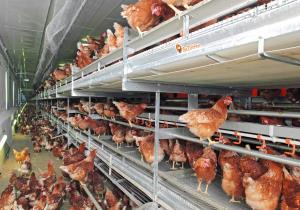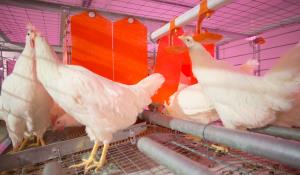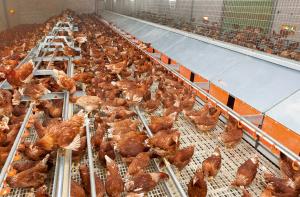 During the past few weeks articles have appeared citing the projected number of hens to be housed under diverse systems by 2025. Various estimates have been made concerning capital cost to achieve conversion adequate to satisfy presumed customer requirements and state mandates. From a review of the fragmentary data and statements it would appear that there is an unrealistic overestimate of the number of hens in cage-free systems by January 2025.
During the past few weeks articles have appeared citing the projected number of hens to be housed under diverse systems by 2025. Various estimates have been made concerning capital cost to achieve conversion adequate to satisfy presumed customer requirements and state mandates. From a review of the fragmentary data and statements it would appear that there is an unrealistic overestimate of the number of hens in cage-free systems by January 2025.
Guestimates of the expenditure required to attain the assumed projected capacity by 2025 are optimistically understated. Figures quoted are presumed to be based on back-of-the envelope calculations and anticipate conversion of existing houses and complexes. In reality the global costs for conversion will include pullet housing, site development, infrastructure and services for a number of new complexes. The restructuring that has occurred and will continue will also require additional feed mills, packing and breaking plants and ancillary installations.
 Many existing high-rise houses are unsuitable for conversion to aviary installations, accepted to be the predominant housing system for egg-producing flocks over the proximal decade. Superficial projections of capital investment ignore the reality that a number of new complexes will be required. This will entail buildings and equipment both of which are escalating with designs becoming more complex to achieve efficiency, sustainability and acceptable standards of biosecurity, environmental compliance, worker safety and flock welfare.
Many existing high-rise houses are unsuitable for conversion to aviary installations, accepted to be the predominant housing system for egg-producing flocks over the proximal decade. Superficial projections of capital investment ignore the reality that a number of new complexes will be required. This will entail buildings and equipment both of which are escalating with designs becoming more complex to achieve efficiency, sustainability and acceptable standards of biosecurity, environmental compliance, worker safety and flock welfare.
Contrary to commitments by the food retail, institutional and service segments of the customer base in the late 2000s it is the opinion of many in the industry that complete conversion from caged housing will not take place by 2025. The prevailing sentiment is incorporated into this projection of required housing by type and market segment including shell and liquid production.
Many complexes built in the early to mid-2000s were equipped with enrichable cages. These units were erected as an insurance strategy in anticipation of a federal Egg Bill that was never enacted. Some of these complexes might be converted to enriched colony modules that were originally accepted by joint agreement between the UEP and the HSUS. Their continued use subsequent to 2025 will be subject to acceptance by customers and consumers and then only in states without a cage-free production and sales mandate.
 The situation regarding hen numbers and housing systems at the end of 2020 is indicated in Figure 1. The corresponding figures allowing for conversion incorporate diversification among alternative systems with expansion, reflecting projected flock sizes for 2025.
The situation regarding hen numbers and housing systems at the end of 2020 is indicated in Figure 1. The corresponding figures allowing for conversion incorporate diversification among alternative systems with expansion, reflecting projected flock sizes for 2025.
A low compound annual rate of expansion of two percent for the shell-egg market was assumed given the moderate overproduction that exists and the anticipated rate of recovery of the economy following COVID. Figure 2 depicts expansion in the egg-liquid segment that will be restrained by moderate demand and limited opportunities for export given significant world competition.
The capital requirement for the projected expansion and conversion is projected in Figure 3. specifying values for alternative housing systems for shell-eggs and in Figure 4 for liquid-egg production.
In addition to housing required for hens, expansion through 2025 will require additional pullet housing, packing plants and feed production. Unit values are specified reflecting costs incorporating an annual escalation of five percent from current values. Projections of cost are based on trends in building and equipment incorporating inflation and progressive complexity dictated by efficiency and sustainability. The projection of capital cost does not include land, employee accommodation, vehicles and assumes availability of road and rail access and available site water and power.
Fig. 1. Current 2020 and Projected 2025 U.S. Hen Population for the Shell Segment (million)
|
Housing System
|
2020 (pre-COVID)
|
2025 (with 2% p.a. compound growth)
|
|
Caged Total
|
144
|
30
|
|
Alternatives to Cages
Aviary
Barn
Pasture
|
50
28
2
|
176
40
4
|
|
Non-Caged Subtotal
|
80
|
220
|
|
All Systems
|
224
|
250
|
Fig. 2. Current 2020 and Projected 2025 U.S. Hen Population For The Liquid Segment
(million)
|
Housing System
|
2020 (pre-COVID)
|
2025 (with 2% p.a. compound growth)
|
|
All Systems
|
96
|
100
|
|
Caged
|
91
|
80
|
Fig. 3. Capital Requirements For Shell Egg Segment by 2025
|
Aviaries (176m-50m) 126 million hen places:
75 million @ $36 conversion
101 million @ $66 new
|
$Billion
$2.700
$6.700
|
|
Floor Systems (40m-28m) 12 million hen places @ $35
|
$0.420
|
|
Pasture Systems (4m-2m) 2 million hens places @ $40
|
$0.080
|
|
Cage Upgrades 30million hen places @ $10
|
$0.300
|
|
Subtotal Shell-Egg Hen Housing
|
$10.200
|
Fig. 4. Capital Requirements For Liquid Segment by 2025
|
Aviaries (20-5)
|
15 million hen places
|
@ $66
|
$0.990
|
|
Cage Upgrades
|
85 million hen places
|
@ $10
|
$0.850
|
|
Subtotal Liquid Egg Hen Housing
|
$1.800
|
Fig. 5 Capital Requirements For Additional Pullet Rearing
|
Pullets required {(127m+30m) = 157/3m} 52 million @$60
|
$3.120
|
|
Capital Requirement for Live Bird Housing
|
$15.120 Billion
|
|
Capital Requirement for Packing Plants
15 units with 2-million hen capacity @ $30 million
|
$0.450
|
|
Capital Requirement for Feed Mixing
3,600 tons per day – 10 plants @ $25 million
|
$0.250
|
|
CAPITAL REQUIREMENT FOR BOTH EXPANSION
AND CONVERSION BY 2025 - Grand Total
|
$15.820 Billion
|

Projecting capital investment for conversion and expansion of the two segments of the U.S. industry predicates realistic assumptions concerning the complement of producing hens and alternative systems of housing to be required by 2025. The forecast of hen numbers is obviously a question of informed estimation. The projection of costs based on flock size for housing systems is based on current estimates with appropriate escalation. The comprehensive figure of $15.8 billion incorporates the reality that expansion and conversion will require not only a change in housing but a fairly substantial restructuring of current production with consolidation and operation of new complexes.